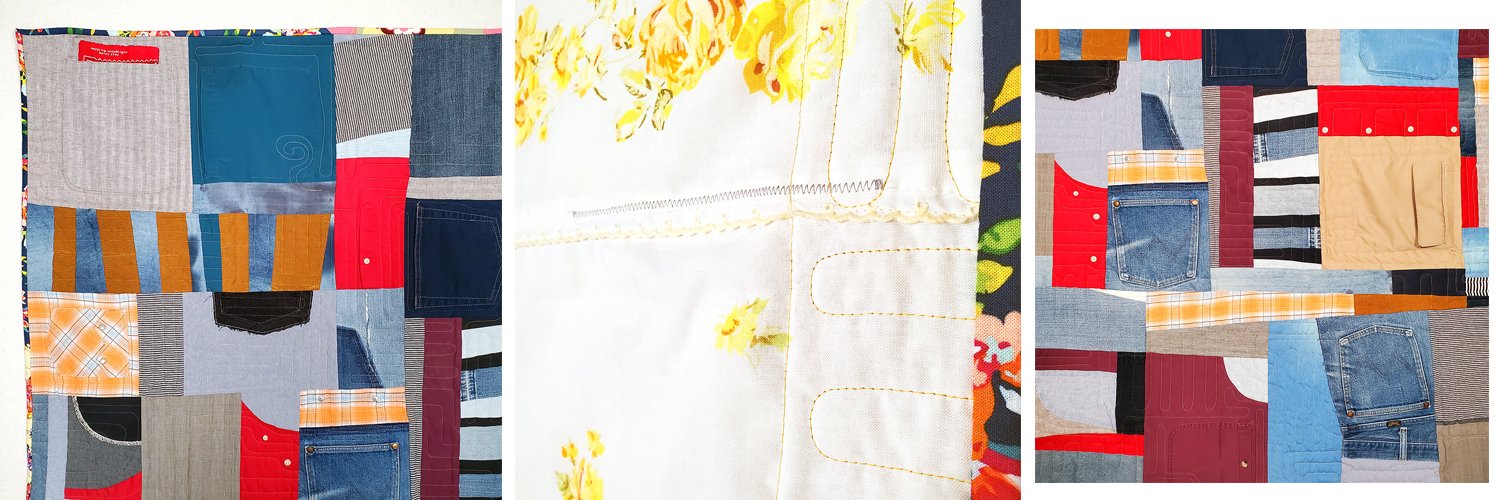This first appeared in the May edition of my newsletter, The Fold. Want to get stories like this delivered straight to your inbox? Sign up here, and be sure to check your email and spam folders for the confirmation.
We interrupt this newsletter to announce that Sarah Atlee is now accepting orders for custom-made quilts!
This is the first time in a long time that I've been available for commissions. I'm really excited about making quilts for collectors, aka folks like you! If you have any questions, or would like to take your next step down the quilted path, please get in touch! sarah@sarahatlee.com
Invest in joy today. Click here to start your custom-made quilt.
Back to The Fold.
I'd like to thank you for joining me on this path. Writing an email newsletter hasn't always been easy for me, but this time around, I'm loving it. I get to share stories with you that matter to me, and you have been so generous in your reception. So pour yourself a hot cuppa and pull up a chair. There's pie.
Now, I'm going to ask you to indulge me, because I am having the most First World Problem ever.
I don't love folding laundry. People know this about me, including my musical friend Paris In Stereo. But I love having clean clothes. So. I learned that you can take laundry to a cleaner's and they'll - get this - wash it, dry it, FOLD IT, and give it back to you. (For a fee.) I don't indulge in this service all the time, but during a busy week, it's a huge help.
I like things folded the Konmari way. The service doesn't fold laundry the Konmari way.
So, do I spend time re-folding my laundry so it's more pleasing to put away? And does this cancel out the convenience of using the service? Or do I accept the folded laundry as-is and live with the daily irritant of my clothes not looking as nice when they're put away? And who even cares? Besides me?
Side note: Before I started The Fold, I asked my Facebook friends to name any associations they had with the word "fold." Angie LaPaglia said,
"I think about laundry. when all the towels are folded and stacked like soft terry cloth soldiers waiting for duty. I think about the act of folding my children’s clothes when they were little, how close to them I felt. I think about everything being folded and put in its place. everything is where it belongs. everything is in order. everyone is tucked in. everyone is safe. everything’s gonna be ok."
Laundry is a small problem that makes a big difference.
I get why we focus on small problems. They’re solvable. Controllable. Can I solve (huge problem affecting every living thing)? Not today, and not alone. Can I fold this t-shirt into its Optimum Form Factor? Watch me. Boom.
I have a challenge for you: Solve a small problem.
Identify something that irritates you, but that you’ve been living with anyway because it’s “too small” to spend energy fixing.
Replace or upgrade a tool that’s worn out.
Discard something that doesn’t fit any more.
Clean that one thing that doesn't usually get cleaned.
Set a boundary, with yourself or with someone else.
These two books will give you some great ideas: Set Boundaries, Find Peace by Nedra Glover Tawwab / The Lazy Genius Way by Kendra Adachi
Please drop me a line and let me know what you fixed! I'm always open to ideas for small improvements.
There's a great recipe coming up, but first, I'd like to introduce you to Basic Split.
Basic Split
Deconstructed garments and other cotton fabrics, machine pieced and quilted by Sarah Atlee.
60 x 43 inches, 2020.
$1,135 Click here to purchase.
Basic Split is, in its own way, a series of small solved problems. The "problem" I set for myself was: take a rectangle, split it, insert a smaller rectangle. Repeat until the quilt is done.
Already have a crush on Basic Split? Wanna make it official? Click here to bring this quilt into your life.
As promised, here's a small improvement that's doing me a world of good:
Stupid Easy Chicken Tortilla Soup
Inspired by the cooking episode of How To ADHD (the salsa chicken starts at 8:59)
In a slow cooker or stovetop soup pot, add:
1 quart of broth
1 jar of salsa
1 packet of taco seasoning
Any amount of chicken in any state (just be mindful of what “bite size” is for you)
Brands don’t matter.
Add any/all of the following:
Extra herbs & spices to taste
1 can diced tomatoes
1 can beans
Potatoes, squash, greens, carrots, celery, onion, in either cooked or raw state (use up your leftovers!)
½ cup uncooked rice
Level 2: Roast the chicken and/or veggies before adding to the soup.
Level 3: Make your own taco seasoning.
Simmer until all the parts are cooked through. Then add 1 can of cream style corn. Wait until it gets hot again, then serve.
Toppings!
(Add these when the soup is being served, not when storing in the fridge/freezer.)
Chopped fresh cilantro
Chopped chives or scallions
Avocado
Shredded cheese
Sour cream or Greek style yogurt
Crunched up tortilla chips
Lime wedges
Makes great leftovers, and freezes well.
Bonus for those who read this far:
Want more in-depth stories, sprinkled with links, delivered to your inbox? Sign up for The Fold. (Check your email and spam folders for the confirmation.) There's a free gift in it for you!
You can also find me at Facebook, Instagram, Pinterest, LinkedIn, and Twitch.













